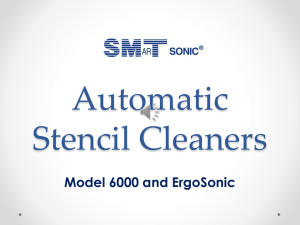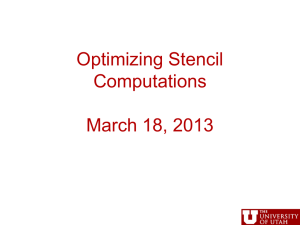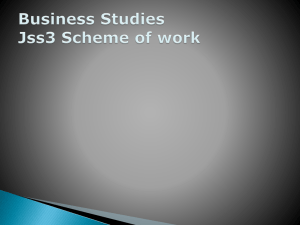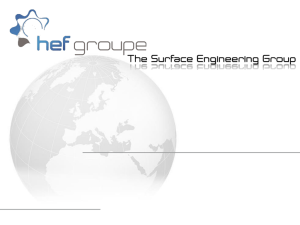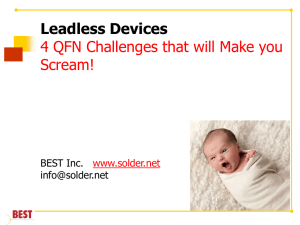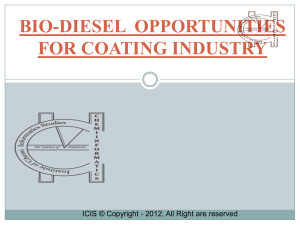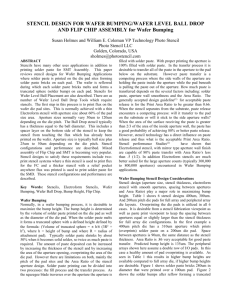Section V Yield Improvement Options 2-16
advertisement
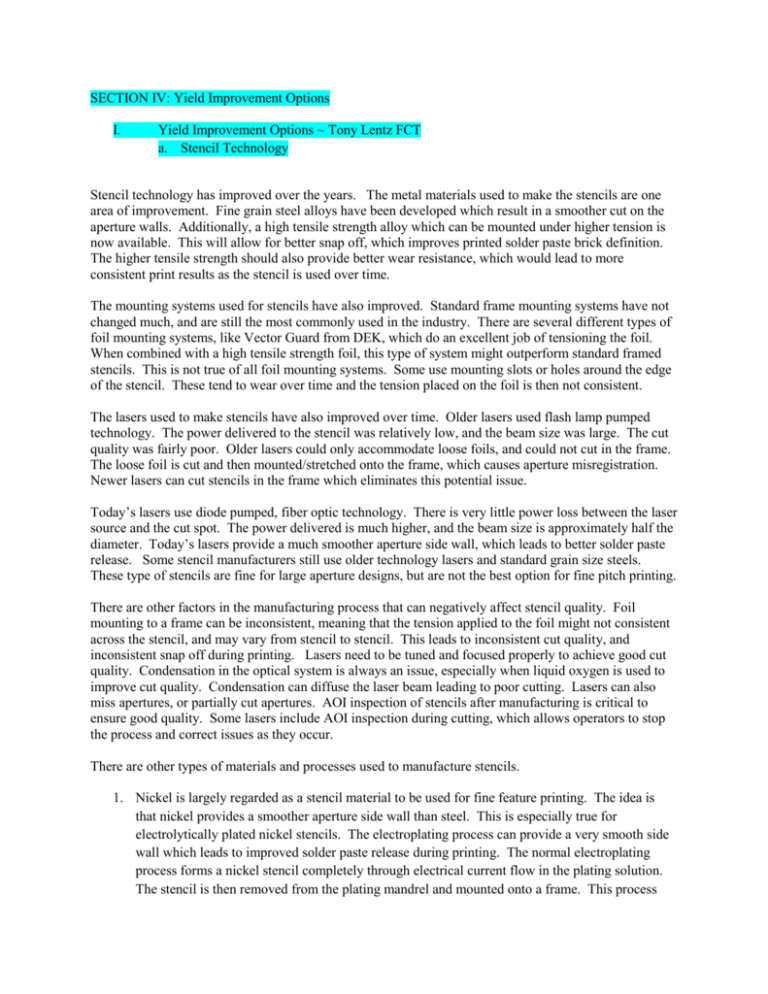
SECTION IV: Yield Improvement Options I. Yield Improvement Options ~ Tony Lentz FCT a. Stencil Technology Stencil technology has improved over the years. The metal materials used to make the stencils are one area of improvement. Fine grain steel alloys have been developed which result in a smoother cut on the aperture walls. Additionally, a high tensile strength alloy which can be mounted under higher tension is now available. This will allow for better snap off, which improves printed solder paste brick definition. The higher tensile strength should also provide better wear resistance, which would lead to more consistent print results as the stencil is used over time. The mounting systems used for stencils have also improved. Standard frame mounting systems have not changed much, and are still the most commonly used in the industry. There are several different types of foil mounting systems, like Vector Guard from DEK, which do an excellent job of tensioning the foil. When combined with a high tensile strength foil, this type of system might outperform standard framed stencils. This is not true of all foil mounting systems. Some use mounting slots or holes around the edge of the stencil. These tend to wear over time and the tension placed on the foil is then not consistent. The lasers used to make stencils have also improved over time. Older lasers used flash lamp pumped technology. The power delivered to the stencil was relatively low, and the beam size was large. The cut quality was fairly poor. Older lasers could only accommodate loose foils, and could not cut in the frame. The loose foil is cut and then mounted/stretched onto the frame, which causes aperture misregistration. Newer lasers can cut stencils in the frame which eliminates this potential issue. Today’s lasers use diode pumped, fiber optic technology. There is very little power loss between the laser source and the cut spot. The power delivered is much higher, and the beam size is approximately half the diameter. Today’s lasers provide a much smoother aperture side wall, which leads to better solder paste release. Some stencil manufacturers still use older technology lasers and standard grain size steels. These type of stencils are fine for large aperture designs, but are not the best option for fine pitch printing. There are other factors in the manufacturing process that can negatively affect stencil quality. Foil mounting to a frame can be inconsistent, meaning that the tension applied to the foil might not consistent across the stencil, and may vary from stencil to stencil. This leads to inconsistent cut quality, and inconsistent snap off during printing. Lasers need to be tuned and focused properly to achieve good cut quality. Condensation in the optical system is always an issue, especially when liquid oxygen is used to improve cut quality. Condensation can diffuse the laser beam leading to poor cutting. Lasers can also miss apertures, or partially cut apertures. AOI inspection of stencils after manufacturing is critical to ensure good quality. Some lasers include AOI inspection during cutting, which allows operators to stop the process and correct issues as they occur. There are other types of materials and processes used to manufacture stencils. 1. Nickel is largely regarded as a stencil material to be used for fine feature printing. The idea is that nickel provides a smoother aperture side wall than steel. This is especially true for electrolytically plated nickel stencils. The electroplating process can provide a very smooth side wall which leads to improved solder paste release during printing. The normal electroplating process forms a nickel stencil completely through electrical current flow in the plating solution. The stencil is then removed from the plating mandrel and mounted onto a frame. This process can produce thickness variations in the plated nickel stencil which lead to solder paste volume variations. The mounting process stretches the stencil slightly which, moves apertures leading to misregistration of the solder paste at print. The benefits of using an electroplated nickel stencil might outweigh these potential issues for the end user. 2. Several variations on this theme are available including laser cut nickel stencils, and nickel plated steel stencils. Laser cut nickel stencils are essentially made the same way as normal laser cut steel stencils. Nickel foil is used in place of steel. The foil is mounted first and then cut in the frame. This process does not have the same potential issues as electroplated nickel stencils with regards to thickness and registration. The sidewalls may not be as smooth as electroplated nickel stencils, and therefore solder paste release might not be as good as plated nickel stencils, but it is likely better than laser cut steel stencils. Nickel plated steel stencils are made through a hybrid of these two processes. The steel foil is laser cut as a loose foil, and then electroplated with a nickel coating. The nickel coating has a smoothing effect on the sidewalls of the aperture. The nickel thickness might not be uniform, which could lead to aperture size inconsistencies. Then the foil is mounted/stretched into the frame, which can lead to aperture misregistration. Again the benefits of this type of stencil might outweigh the potential negatives of aperture size inconsistency and misregistration. Chemical polishing has been used for many years to improve the smoothness of the apertures. Chemical polishing is typically done with an electrical micro-etching process. Electrical current is used to remove metal from the apertures, preferentially from the high spots leading to a smoother side wall. This process is typically used on laser cut steel stencils, and has to be done with loose foil. Again the foil would have to be mounted in the frame after this is complete. II. Nano-Coatings a. Nano-coatings i. How long do the coatings last In the squeegee transfer process, the goal is for the solder paste to have a stronger attraction to the PCB than to the walls of the apertures. This process is affected primarily by the stencil’s design, although the solder paste and the speed of the board separation also have influence. The design of the stencil introduces many factors. The material used to construct the stencil of and how the stencil manufacture creates the stencil affect this process. A number known as the area ratio, which is defined as the ratio of the aperture opening on the PCB side to the area of the aperture walls, is commonly used as a measure of the adhesive forces. As the area ratio decreases, the force applied to the paste by the aperture walls increases, causing a decrease in the transfer of the solder paste from the stencil to the PCB. The very definition of the area ratio underscores the importance of another key variable, the wall smoothness. A smoother wall will exert less adhesion to the paste than a rougher one. The roughness can be controlled by various methods for forming the apertures (e.g. laser cutting and electroforming). A method for modifying the stencil surface is to apply a hydrophobic coating in an effort to improve solder paste release. Nano-coated stencils work in two complementary ways to reduce the adhesive force between the paste and the aperture. First, by adding the extremely thin coating, the roughness of the aperture is reduced. Additionally, the coating fills in some of the “valleys” in the surface topology. This coating on the aperture wall decreases the adhesion forces. The coating chemically modifies the surface of the aperture and decreases the chemical attraction that the paste has to the metal surface. The theory behind nano-coating has to do with high or low surface energy, terms that denote how liquids interact with the surfaces. Unmodified metal surfaces are typically high surface energy. Surfaces with high surface energy are held together by strong or high energy chemical bonds (ionic, covalent, or metallic). High energy surfaces are typically able to be wetted (a liquid can readily spread over the surface of the material) by most liquids due to the interaction of the surface and the liquid being stronger than the interaction between liquid molecules. Low energy solids, on the other hand, are held together primarily through physical interactions, such as hydrogen “bonds” or Van der Waals forces. Since these surfaces interact with liquids via weaker methods, the surface tension of the liquid is too great for the surface to overcome, and the liquid does not spread. Nano-coatings modify the surface through the use of low energy molecules which, when applied to a metal surface, chemically bonds with that surface, forming a low energy coating. This coating decreases the interaction between the paste and the aperture, allowing for a cleaner release. There are two basic types of nano-coatings used in North America. Self-assembled monolayer phosphonates (SAMP) are the commonly used, wipe on type of coating. Wipe on nano-coatings are available from many stencil suppliers. The second type of coating is a thermally cured fluoropolymer which are supplied by a few stencil companies. The life span of a nano-coating is directly related to its chemical nature and physical properties. A. Fluoropolymers: Thermally cured polymer type coatings are much thicker than wipe on coatings, and are visible on the stencil. A dye is added to the fluoropolymer to give it a color which makes it easier to see. These polymer type coatings are on the order of 1-4 microns thick as opposed to the SAMP wipe on coatings which are 1-4 nanometers thick. After curing is complete, the polymer type coatings have a pencil hardness of 9H, which is similar to the pencil hardness of solder masks used on circuit boards. The polymer type coatings can be damaged mechanically, without signs of wear from normal printing and cleaning operations. Some users report use of stencils for over 30,000 prints and the coating is working normally. The thermally cured polymer coatings are susceptible to chemical attack from both strong acids and strong bases. Strong acids (pH < 2) tend to break the bond between the coating and the steel substrate and the coating lifts off of the stencil. Most stencil cleaning chemistries are not acidic, so this is not a concern for end users. Strong bases (pH > 11) tend to hydrolyze the internal bonds in the coating working from the surface downwards. The coating remains physically intact but the surface loses it’s “fluxophobic” properties. This is a slow process and depends largely upon the nature of the bases used in the cleaning chemistry. For example, 50% wt. monoethanolamine does not affect the coating, but 1.0 N sodium hydroxide does. Most stencil cleaning chemistries use solvents, surfactants, and/or weak bases. Over 25 commercially available stencil cleaners have been tested, while only one that attacked the coating. That particular cleaner had a pH > 11. Thermally cured polymer type coatings are reported to last for the life of the stencil. B. Wipe on coatings are essentially one molecule thick, and are invisible on the stencil. Testing has shown that these type of coatings wear off fairly quickly through underside cleaning. Chemicals used in conjunction with underside cleaning speed the rate of wear. Some users have commented that wipe on coatings are easily removed during stencil cleaning in cleaning machines. The coatings may be removed after only 1 or 2 cleaning cycles. This is likely due to chemical interaction with the coating, and not necessarily due to mechanical removal. One issue with wipe on coatings is that the user cannot see the coating and therefore cannot see when the coating has been removed. Markers are available that can test the surface tension of the coating, and can be used to identify when the coating is no longer working. Sharpie type markers have been used to test for coating presence. If the marker fails to stick or beads up, coating is still present. Since the coating cannot be seen with the visible eye, assemblers need a method for quantifying the coating levels present on the stencil. Additionally, chemical compatibility between the nano-coating and cleaning agents used to clean stencils and squeegees must be determined. Currently, there is as paucity of literature detailing effective ways of measuring the performance of the coating. There are two suggested methods by which to evaluate the performance of the nano-coating, both of which are subjective. The first method is the least subjective and consists of placing a drop of water on the stencil and observing whether it beads up. If it fails to do so, then the coating is absent or damaged. The other, more subjective method entails marking the coated surface and seeing how easily the marking is removed. Currently, no special recommendations for cleaning nano-coated stencils exist. The cleaning process typically involves three steps that take place in the order listed: wet, vacuum, dry. The wet cleaning involves running the PCB side of the stencil over a cleaning wipe that has been wetted with a cleaning agent. This process is then followed by running the same side of the stencil over a dry wipe while a vacuum is applied to the other side of the wipe. This step helps to dry the residual cleaning agent on the stencil as well as to remove solder balls. Finally, the stencil is passed over a dry wipe. a. ii. 1. 2. 3. 4. 5. Nano-coatings Material compatibility of coatings Solder Paste Paper Underwipe solvents Stencil Cleaning off the printer Print Pressure and Squeegee blade abrasion Solder paste compatibility: A variety of solder pastes on the polymer type nano-coating and found no issues. Solder paste formulations do not contain strong acids or bases, and are typically pH buffered closer to neutrality. Solder paste obviously contains metal particles which are abrasive. As solder pastes are printed through the apertures, and cleaned off of the bottom of the stencil there can be some abrasion wear of the coating. As for the wipe on coatings, wear is a combination of mechanical wear, chemical removal, and possibly solder paste incompatibility. Paper compatibility: Content Needed We have never tested different types of papers with the nano-coatings, so I cannot give any useful information here. Under-wipe solvents: Thermally cured polymer coatings are compatible with a variety of under-wipe solvents. I have not found a solvent based product that can affect the polymer type coating. High pH >11 cleaners can affect the coating, but I do not believe these are commonly used for under-stencil cleaning. Stencil cleaning off the printer: As I mentioned above, most stencil cleaning chemistries are compatible with thermally cured polymer type coatings. The only issue we have found is with high pH>11 cleaners. The equipment used for stencil cleaning, whether automated or manual does not seem to have an effect on the polymer coating. Our customers use all manner of cleaning equipment with good results. Print pressure and squeegee blade abrasion: Print pressure and squeegee blade abrasion can damage thermally cured polymer type coatings. I have seen this occur twice with our coating. The coating was essentially scraped off around the perimeter of the board edge. The print pressure may have been set too high, and the board edges may have been more sharp than usual. I do not have the details on the parameters that were used. Interestingly enough, the coating remained intact on the stencil in the board print area, so it was still functional. We have hundreds of customers using our coating with no issues, so this is a rare problem. Intuitively it makes sense that high blade pressure and poor board support can combine to create damage from the sharp edges of the board.
